Prolactin is a hormone secreted by the pituitary gland, located at the base of the brain. Prolactin is essential for the formation of breast milk after birth. On the other hand, the thyroid gland is located in the front of the neck and secretes the thyroid hormones – triiodothyronine (T3) and thyroxine (T4). It controls metabolic processes, body temperature and heart function. So what is the relationship between thyroid and prolactin? The answer lies in the brain and more precisely in the hypothalamus. This small part of the brain consists of several small nuclei that have a variety of functions. They control body weight and appetite, thirst, body temperature, sleep-wake rhythm, sexual function, memory, blood pressure, and other important functions. The main tool of the hypothalamus, with which it performs all these processes, is the pituitary gland. The hypothalamus and pituitary gland are related to the other glands in the body in hierarchical systems. Highest on the “throne” stands the hypothalamus, which gives out “commands”. Immediately below it is the pituitary gland, which distributes the tasks between the other “subordinate” glands – the thyroid, adrenal glands and gonads. The increased levels of the hormones released by them serve as feedback to the hypothalamus and pituitary gland for a “job well done”. The commands that the hypothalamus gives are in the form of stimulating hormones. Specifically for the hypothalamus-pituitary-thyroid axis, this is the hormone TRH (thyroid-stimulating releasing hormone). TRH binds to specific cells in the pituitary gland called thyrotrophs, which secrete the hormone TSH (thyroid-stimulating hormone). TSH serves as a signal for the thyroid gland to secrete T3 and T4. But what happens if the thyroid doesn’t respond to commands? The hormones T3 and T4 can be likened to a kind of echo that reaches the “ears” of the hypothalamus and pituitary gland, and accordingly to a drop in the levels of TRH and TSH. When the hypothalamus does not receive the expected feedback, it begins to secrete more TRH, and therefore TSH from the pituitary gland, in an effort to normalize the balance of T3 and T4 in the blood. On the basis of this feedback, the diagnosis of thyroid diseases is carried out. In reduced thyroid function (hypothyroidism), it remains “deaf” to the signals of the hypothalamus and pituitary gland and does not secrete T3 and T4, resulting in high levels of TRH and TSH in the blood. We’ll see how this affects prolactin in a moment. Prolactin, like TSH, is secreted by pituitary cells called lactotrophs. Prolactin secretion is controlled by inhibitory and stimulatory signals. The main regulatory mechanism is suppressive. It is carried out by means of the neurotransmitter dopamine from the hypothalamus. It maintains a certain level of prolactin, not allowing it to exceed the upper limit of the norm. In case of need, stimulating signals reach the pituitary gland that increase prolactin secretion. The most powerful such stimulus is the baby’s sucking during breastfeeding.Another major regulator is estrogen, which can significantly increase prolactin levels, which explains its higher upper limit in women. And here comes the connection of the thyroid gland with prolactin, namely the TRH hormone. It acts as a stimulating factor, in addition to TSH, but also prolactin secretion. Elevation of TRH in hypothyroidism results in increased release of prolactin from the pituitary gland. Hyperporlactinemia, in turn, suppresses sexual function and leads to menstrual disorders and even absence of menstruation in women and erectile dysfunction in men. The result in both sexes is infertility. Therefore, thyroid function is always examined in addition to prolactin levels when evaluating reproductive problems. And another important point – when hyperprolactinemia is established, hypothyroidism must be ruled out. If present, thyroid function should first be normalized with T4, then prolactin levels should be monitored again. High prolactin with normal TSH levels requires looking for another cause of this problem. References: Mariotti S, Beck-Peccoz P. Physiology of the Hypothalamic-Pituitary-Thyroid Axis. 2021 Apr 20 Endotext [Internet]. South Dartmouth (MA): MDText.com, Inc.; 2000�. PMID: 25905193. Norman AW, Henry HL, eds. (2014). III. Structure, Synthesis, Secretion, and Target Cells of the Hypothalamic Releasing Hormones: E. Hypothalamic Control of Prolactin Secretion”.Hormones. Academic Press. p.66.ISBN 9780080919065. Glezer A, Bronstein MD. Hyperprolactinemia. 2022 Jan 5. Endotext [ Internet]. South Dartmouth (MA): MDText.com; 2000�.PMID: 25905218.Synthesis, Secretion, and Target Cells of the Hypothalamic Releasing Hormones: E. Hypothalamic Control of Prolactin Secretion”.Hormones. Academic Press. p.66.ISBN 9780080919065. Glezer A, Bronstein MD. Hyperprolactinemia. 2022 Jan 5. Endotext [Internet] .South Dartmouth (MA): MDText, Inc.; 2000�.PMID: 25905218.Synthesis, Secretion, and Target Cells of the Hypothalamic Releasing Hormones: E. Hypothalamic Control of Prolactin Secretion”.Hormones. Academic Press. p.66.ISBN 9780080919065. Glezer A, Bronstein MD. Hyperprolactinemia. 2022 Jan 5. Endotext [Internet] .South Dartmouth (MA): MDText, Inc.; 2000�.PMID: 25905218.


Leave a Reply